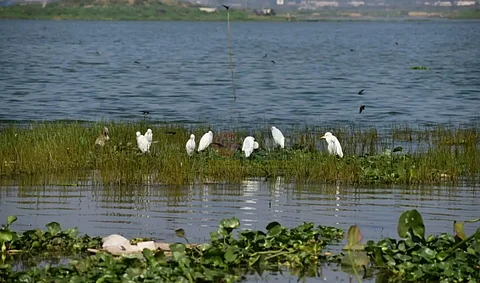
- Home
- Live Blog
- Breaking News
- Top Headlines
- Cities
- NE News
- Sentinel Media
- Sports
- Education
- Jobs

The Eco Sensitive Zone (ESZ) acts as a shock absorber of protected areas, as it regulates development activities around a protected area for maintaining the ecological balance. Demarcation of the ESZ of Deepor Beel is a crucial step for the conservation of this lone Ramsar site in Assam. The new draft notification issued by the Ministry of Environment, Forest and Climate Change (MoEFCC) significantly reduces the area under the proposed ESZ compared to the area proposed in the previous draft notification issued by the Ministry in 2021. The new notification proposes that the ESZ will extend from 25.294 metres to 5 km around the boundary of the wetland. This is a clear departure from the ESZ area proposed in 2021. The previous notification proposed that the ESZ shall be to an extent of 294 metres to 16.32 kilometres around the boundary of Deepar Beel Wildlife Sanctuary, and the area of the ESZ is 148.97 sq. km. This area is now proposed to be drastically reduced to 38.84 sq km, which raises concern over the impact of unregulated activities outside the notified ESZ around the largest freshwater lake.The natural span of Deepor Beel is 40 sq. km in the summer and reduces to about 10 sq. km in the winter, of which an area of 4.1 sq. km was notified as a wildlife sanctuary by the state government in 2009. A safe sanctuary of about 150 species of birds, including the migratory bird species, makes it a unique habitat for aquatic flora and fauna. It also provides an important space for food and ranging for elephant herds that visit Deepor Beel from the adjoining Rani and Garbhanga Reserved Forest. Besides these, about a dozen species of reptiles, 50 species of fishes, and six species of amphibians, along with 155 species of aquatic macro-biota make it a natural laboratory for wildlife biologists to conduct research on important species, including critically endangered, endangered, vulnerable, and threatened species. The Himalayan hoary-bellied squirrel (Callosciurus pygerythrus), house shrew (Suncus murinus), pygmy shrew (Suncus etruscus), large bandicoot rat (Bandicota indica), lesser bandicoot rat (Bandicota bengalensis), black rat (Rattus rattus), Chinese porcupine (Hystrix brachyura), Indian hare (Lepus nigricollis), barking deer (Muntiacus muntjak), sambar (Cervus unicolor), Indian flying fox (Pteropus gigenteus), long-winged tom bat (Taphozous longimanus), Rhesus macaque (Macaca mulatta), Asiatic jackel (Canis aureus), common otter (Lutralutra), large Indian civet (Viverrazibetha), small Indian civet (Viverricula indica), Indian mongoose (Herpestes javanicus), etc are also found in Deepor Beel area. An irreversible impact of its ecology on account of unregulated human activities, including infrastructure and construction activities around the wetland, will only increase the vulnerabilities of various species, and it will no longer remain a safe sanctuary for them. Failure to finalise the previous draft notification and implementation of the zonal Master Plan for ESZ allowed rampant growth of industries and human settlements within the proposed ESZ area, as there was no clarity on the demarcation of Deepor Beel boundaries. The new notification states that the Zonal Master Plan, which is to be prepared within two years of the final ESZ notification, shall not impose any restriction on the approved land use, infrastructure and activities and shall factor in improvement of all infrastructure and activities to be more efficient and eco-friendly. The likely consequences of incorporating this provision in the Master Plan need to be thoroughly discussed, as infrastructure development in an ecosystem fragments it, posing survival challenges for various wildlife species, and also leads to rapid degradation of the ecology, which cannot be reversed. Ecosystems are continuous, and drastic changes in ecology on the fringe cannot happen in isolation. Pollution of Deepor Beel water due to dumping of municipal solid waste, including plastic waste, near its boundary demonstrates how the rapid expansion and growth in Guwahati has posed an existential threat to aquatic species, which has a direct impact on resident and migratory birds. Similarly, fragmentation of the elephant corridor due to the laying of the Guwahati-Goalpara railway line increased the vulnerability of elephants getting killed in train hits. The Deepor Beel’s critical role in mitigating floods in Guwahati by regulating monsoon runoff from the city could be jeopardised if the water channels and natural drainage system are destroyed and encroached upon due to unregulated development activities around its boundary. The eco-tourism importance of Deepor Beel will rapidly diminish if the ecology and its natural environment are not conserved and are gradually lost in fast-paced development. The draft notification needs to be widely publicised, enabling experts and citizens to give their informed feedback so that the final notification will incorporate all checks and balances. A strong oversight mechanism will be crucial to ensure that permitted activities are efficiently regulated in ESZ. Conservation of the ecosystem of Deepor Beel and its buffer zone is crucial for sustainable growth of Guwahati and surrounding peri-urban areas, which needs to be kept in mind while finalising the ESZ.